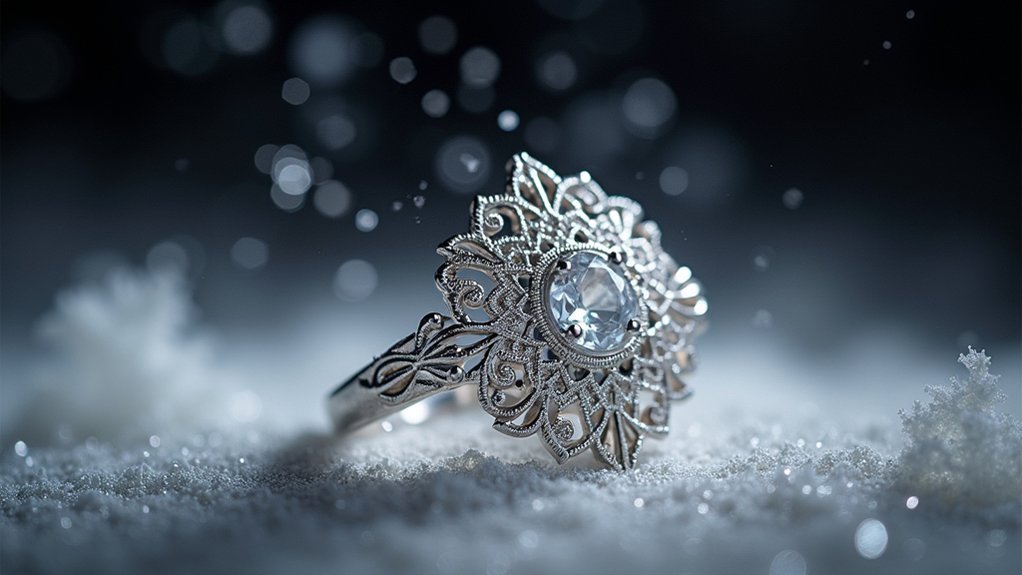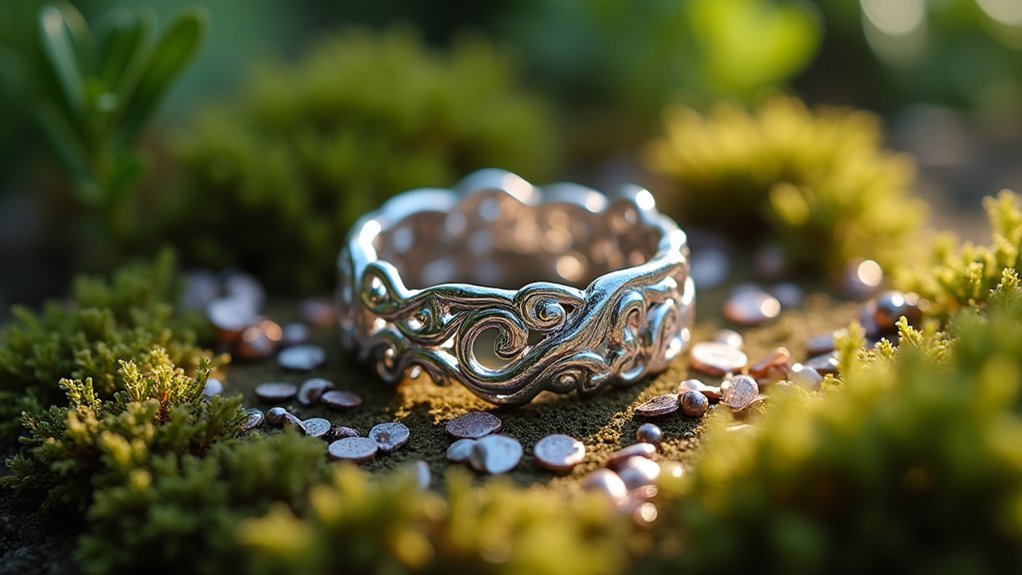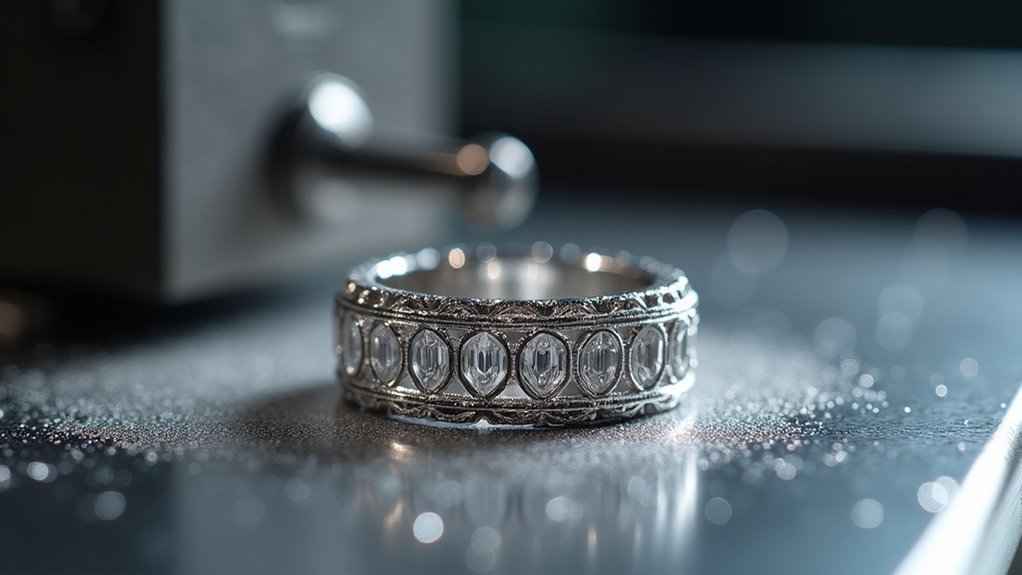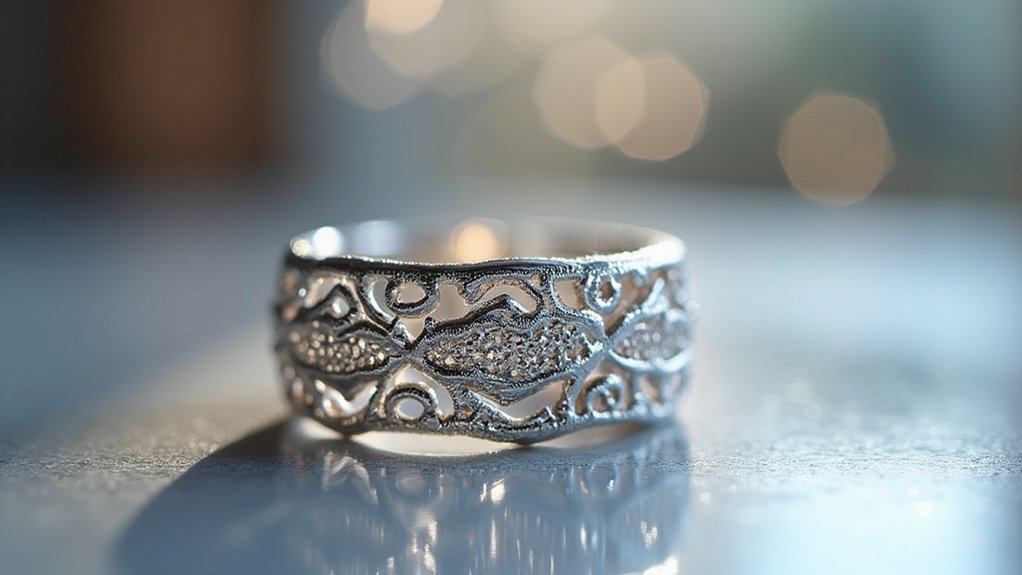You’ll discover that 3D printing platinum rings revolutionizes jewelry creation through advanced Laser Powder Bed Fusion technology, which melts platinum particles layer by layer with exceptional precision. This process enables intricate designs impossible with traditional casting while reducing material waste by up to 90%. You can achieve ultra-thin wall thicknesses of 0.30-0.35 mm and tolerances within +/- 0.1 mm for perfect fit. The technology supports complex internal structures, hidden compartments, and bespoke personalization that’ll transform your understanding of platinum craftsmanship.
Advanced Laser Powder Bed Fusion Technology for Platinum Processing

When traditional jewelry manufacturing hits its limits, advanced laser powder bed fusion technology revolutionizes platinum ring production by precisely melting platinum particles layer by layer.
You’ll find this method creates intricate designs with exceptional material density while generating minimal waste during production.
The technology enables you to achieve remarkably thin wall thicknesses between 0.30mm and 0.35mm, producing lightweight yet durable structures.
Platinum’s naturally low reflectivity works to your advantage, making the laser processing more energy-efficient and providing superior heat control throughout printing jewelry creation.
Platinum’s low reflectivity enhances laser efficiency and heat control, making it ideal for precision 3D printing applications.
You’ll appreciate how this precious metal 3D printing eliminates Hot Isostatic Pressing requirements in many cases, streamlining your workflow and reducing lead times.
This advancement opens doors to bespoke platinum ring designs that were previously impossible with conventional manufacturing techniques.
Intricate Design Capabilities Beyond Traditional Casting Limitations
While traditional casting methods confine you to relatively simple geometries, 3D printing releases unprecedented design freedom that transforms how you’ll approach platinum ring creation.
You’ll discover that additive manufacturing enables intricate shapes previously impossible with conventional techniques. Through precise layer-by-layer construction, you can create complex internal structures, flowing organic forms, and geometric patterns that would’ve required multiple casting steps or proved entirely unfeasible.
Printed platinum jewellery opens remarkable possibilities:
- Lattice structures – Create lightweight yet strong internal frameworks
- Hollow chambers – Design rings with hidden compartments or reduced material usage
- Interlocking elements – Produce moving parts assembled during printing
- Organic geometries – Craft flowing, nature-inspired forms with seamless shifts
You’ll achieve designs that push creative boundaries while maintaining platinum’s structural integrity, transforming traditional jewelry concepts into innovative, personalized luxury pieces.
Reduced Material Waste and Environmental Benefits

You’ll discover that 3D printing platinum rings dramatically cuts material waste by up to 90% compared to traditional casting methods.
The additive manufacturing process eliminates the harsh chemical treatments typically required for conventional jewelry production, reducing your environmental footprint considerably.
This sustainable approach means you’re choosing a manufacturing method that preserves precious resources while creating your unique piece.
Minimized Chemical Waste
As 3D printing technology revolutionizes platinum ring production, you’ll discover dramatic reductions in both material and chemical waste that traditional manufacturing methods can’t match.
This additive manufacturing approach eliminates numerous hazardous substances typically required in conventional jewellery casting and finishing processes.
When you choose 3D printing for platinum rings, you’re supporting sustainable jewellery practices that markedly minimize chemical waste throughout production.
The technology streamlines manufacturing by removing multiple chemical-intensive steps.
Key chemical waste reductions include:
- Elimination of harsh casting chemicals and toxic solvents
- Reduced need for aggressive polishing compounds and acids
- Minimized use of chemical etching and cleaning agents
- Decreased reliance on hazardous plating and finishing substances
This cleaner production method aligns perfectly with growing consumer demand for environmentally responsible luxury goods.
Sustainable Manufacturing Process
Beyond chemical waste reduction, 3D printing transforms platinum ring manufacturing into a remarkably sustainable process that dramatically cuts material waste.
You’ll find that additive manufacturing uses only the exact amount of platinum needed for each design, eliminating the offcuts and excess material typical in traditional casting methods. This precision approach means you’re maximizing every gram of precious metal while minimizing environmental impact.
The sustainable manufacturing benefits extend beyond material efficiency. You can create intricate, bespoke designs without overproduction concerns, encouraging responsible consumption practices.
Since 3D printing builds platinum jewelry layer by layer, you’re not dealing with the resource-intensive processes of conventional manufacturing. This shift toward sustainable luxury prioritizes environmental responsibility while maintaining the high-end quality you expect from platinum jewelry.
Precision Wall Thickness and Structural Integrity
When you’re 3D printing platinum rings, you’ll need to maintain a minimum wall thickness of 0.30 mm to preserve the material’s structural integrity throughout the manufacturing process.
This precision requirement transforms how you approach structural design, allowing you to create lightweight yet durable pieces that maintain platinum’s exceptional strength properties.
You’ll find that laser powder bed fusion technology meets these exacting manufacturing standards while eliminating the additional processing steps typically required in traditional casting methods.
Minimum Wall Requirements
While traditional jewelry manufacturing allows for delicate details and thin structures, 3D printing platinum requires adherence to specific minimum wall requirements that guarantee your ring won’t crack or collapse during production.
Your 3D printed platinum ring’s structural integrity depends on meeting these critical thickness standards:
- Wall thickness: Both supported and unsupported walls must measure at least 0.8 mm thick to withstand the printing process.
- Wire specifications: Unsupported wires need 1.0 mm minimum thickness, while supported wires can be 0.8 mm.
- Part clearance: Maintain 0.3 mm spacing between components to prevent unwanted fusion during printing and cleaning.
- Detail dimensions: Embossed features require 0.4 mm height and width, while engraved details need 0.35 mm using sans-serif fonts.
These specifications guarantee your platinum ring maintains durability while achieving the precise geometry that makes 3D printing unique.
Structural Design Advantages
Precision wall thickness capabilities distinguish 3D printed platinum rings from traditionally manufactured jewelry, enabling you to achieve structural elements as thin as 0.30 mm without sacrificing durability.
This level of precision isn’t possible with traditional methods like casting, where such thin walls would compromise the ring’s integrity.
Laser powder bed fusion enhances structural integrity by creating high material density while maintaining lightweight constructions.
You’ll benefit from complex geometries including lattices and hollow designs that optimize both visual appeal and strength simultaneously.
The additive manufacturing process eliminates material waste compared to traditional methods, ensuring efficient platinum utilization without compromising structural performance.
Through 3D printing, you can customize bespoke designs tailored to your specific preferences while maintaining exceptional strength and durability throughout the ring’s structure.
Precision Manufacturing Standards
Tolerances in 3D printed platinum rings reach exceptional standards, with inner diameter precision typically maintained within +/- 0.1 to 0.15 mm for perfect comfort and fit.
This level of accuracy transforms how you’ll experience precious metal jewelry manufacturing, delivering consistency that traditional methods struggle to match.
The precision manufacturing standards for 3D printing platinum rings include:
- Ultra-thin wall construction – Achieve 0.30-0.35 mm thickness while maintaining structural integrity
- Laser powder bed fusion accuracy – Creates lightweight yet durable platinum structures without strength compromise
- Detailed feature specifications – Embossed and engraved elements require minimum 0.4 mm dimensions for maximum visibility
- Reduced material waste – Additive manufacturing eliminates excess precious metal consumption compared to casting
You’ll find these standards guarantee every ring meets exacting specifications while maximizing material efficiency and design possibilities.
Bespoke Manufacturing and Personalization Options
Since 3D printing technology transforms how platinum rings are conceived and crafted, you’ll discover unprecedented opportunities for creating truly personalized jewelry that reflects your individual style and preferences.
Bespoke manufacturing through 3D printing eliminates traditional constraints, enabling you to design intricate details impossible with conventional methods. You can create modular designs, mixing and matching components like interchangeable cuffs and bands. The customization process includes precise sizing adjustments during printing, eliminating post-production modifications.
| Feature | Traditional Method | 3D Printing |
|---|---|---|
| Design Complexity | Limited patterns | Unlimited intricacy |
| Material Waste | High excess | Minimal waste |
| Prototyping Speed | Weeks required | Hours completion |
| Size Adjustments | Post-production only | During printing |
| Component Modularity | Fixed design | Interchangeable parts |
Digital design capabilities allow rapid prototyping with immediate client feedback integration, streamlining your customization experience while maintaining platinum’s luxury appeal sustainably.
Technical Challenges and Solutions in Platinum 3D Printing

Although platinum’s exceptional properties make it ideal for luxury jewelry, they create formidable obstacles when you’re working with 3D printing technology. The metal’s exceptional melting point and strength demand extensive calibration and collaboration between engineers and jewelers.
However, you’ll find that solutions have emerged through persistent innovation.
Key breakthrough solutions include:
- Energy-efficient laser printing – Platinum’s low reflectivity and effective heat control optimize precision during printing
- Extensive experimentation protocols – Months of testing developed reliable calibration methods for consistent results
- Advanced material handling – Specialized techniques reduce waste compared to traditional casting methods
- Collaborative development – Cross-disciplinary teamwork overcame complex technical challenges in jewelry production
These solutions transform platinum printing from experimental novelty into viable commercial reality for intricate, bespoke designs.
Commercial Viability and Market Applications
While technical breakthroughs solved platinum’s printing challenges, the real test comes in commercial markets where consumers demand both innovation and value.
The Tùsaire Collection proves this precious metal’s 3D printing commercial viability as the first platinum-focused jewelry line using direct metal printing. You’re witnessing remarkable market growth—global platinum jewelry demand increased 8% in 2024, largely driven by 3D printed designs’ customization appeal.
You’ll find 3D printing delivers what traditional methods can’t: lightweight, complex structures through laser powder bed fusion that captivate modern consumers.
The technology reduces material waste and chemical usage, improving sustainability and cost-effectiveness. With projected 2% growth in 2025, platinum’s market viability strengthens as innovative manufacturing techniques gain consumer traction.
Quality Standards and Finishing Techniques for Platinum Rings
Because platinum’s exceptional melting point of 1,768°C demands precise control during 3D printing, you’ll need to master specialized finishing techniques that transform raw printed pieces into professional-quality rings.
When working with this precious metal, you’ll encounter unique challenges that require specific approaches:
- Wall thickness precision – Maintain 0.8mm minimum for supported structures and 1.0mm for unsupported areas
- Tolerance control – Achieve inner diameter accuracy within +/- 0.1 to 0.15mm for proper fit
- Selective polishing – Focus on accessible surfaces while leaving internal details unpolished
- Post-printing cleaning – Remove support material and debris before final finishing
These finishing techniques guarantee your 3D printing process delivers rings with structural integrity and professional aesthetics that meet industry quality standards.
Frequently Asked Questions
Can Platinum Be 3D Printed?
Yes, you can 3D print platinum using laser powder bed fusion technology. You’ll need extensive technical expertise and calibration due to platinum’s high melting point, but it enables intricate designs and reduces material waste.
What Makes 3D Printing Unique?
You’ll create complex geometries impossible with traditional methods while reducing material waste. You can rapidly prototype custom designs and produce lightweight, intricate structures with fine details that weren’t previously achievable.
What Is the Best Material for 3D Printed Jewelry?
You’ll find platinum’s the best material for 3D printed jewelry. It’s 95% platinum and 5% ruthenium, giving you incredible durability, intricate design possibilities, and that professional finish you’re looking for in luxury pieces.
Is 90% of All Jewelry Made Using 3D Printing?
No, you’ll find that only 5-10% of jewelry uses 3D printing currently. You’re looking at a field where traditional methods still dominate, though 3D printing’s growing rapidly with 18% projected growth.





Leave a Reply